Current location: Home > Biological Effects Model > 1° Driver: Susceptibility > 2° Driver: Exposure to High Water Temperatures |
|
Secondary Driver: Exposure to Jump down this page to: Steelhead | Chinook Salmon | Delta Smelt | Longfin Smelt | Sacramento Splittail | White Sturgeon | Green Sturgeon | Striped Bass Water temperature can strongly influence the effects of low DO on fish because increasing temperature raises the metabolic requirements of fish and decreases the amount of oxygen that can dissolve in water. Seasonal variability in water temperature can be an important consideration in assessing the effects of low DO concentrations on fish. Most fish species have well-defined species-specific temperature maxima because of the:
In the DWSC, the highest temperatures are from June through September, which coincides with the lowest DO concentrations (6 mg/L and below). Fish species that are present in the DWSC during these months would be affected the most by the combination of warm water temperatures and low DO concentrations. Chinook salmon and steelhead are coldwater fish and are more sensitive to water temperatures above 15°C than other fish species in the DWSC. Jump to "General Effects" discussion under other Secondary Drivers: Steelhead (Oncorhynchus mykiss) Hypothesis: High water temperatures encountered by migrating adult and juvenile steelhead trout in the DWSC increase the incipient limiting and lethal threshold concentrations for DO (the level below which adverse effects or mortality may occur) above the thresholds under normal temperatures. 1. How does this driver operate? Many studies of the synergistic effects of water temperature and DO on steelhead have been published. This species is relatively intolerant of high water temperatures and low DO concentrations. Higher water temperatures can magnify hypoxic stress by increasing metabolic rate (and thus oxygen demand) and reducing the solubility of oxygen in water (Ebersole et al. 2001). Above certain thresholds, water temperature increases the incidence of mortality and adverse sublethal effects associated with low DO concentrations. 2. Are there critical thresholds associated with this driver? In general, migrating and holding adults experience increased stress as water temperatures increase from 14 to 21°C, potentially resulting in deterioration of physical condition and reduced spawning success (McCullough 1999). Adult steelhead appear to be much more sensitive to thermal extremes than juveniles (McCullough 1999). Preferred migration temperatures for steelhead range between 7 and 11°C (NOAA Fisheries 2000). Lethal water temperatures of 21°C were observed in the Columbia River for steelhead acclimated to a river temperature of 19°C (McCullough 1999). Juvenile rearing success is assumed to decline at water temperatures ranging from 17 to 25°C (Raleigh et al. 1984). Juvenile steelhead have been observed to migrate downstream through the Delta at water temperatures substantially warmer than 13°C and have been captured at Chipps Island in June and July and at water temperatures exceeding 20°C (Nobriega and Cadrett 2001). Juvenile steelhead can be expected to show significant mortality at temperatures exceeding 25°C (Raleigh et al. 1984; Myrick and Cech 2000). Smolting steelhead require cooler temperatures than rearing juveniles; successful smolt transformation occurs at temperatures ranging from 6 to 10°C. Water temperature warmer than 13°C prevents increases in ATPase activity (Hoar 1988 in McCullough 1999). Zaug and Wagner (1973 in McCullough 1999) found that steelhead require temperatures cooler than 13°C to successfully complete smolt transformation. When temperatures exceeded 13°C, fish that had already begun the smoltification process reduced ATPase activity and lost the ability to migrate. 3. How important is this driver? Water temperature is an important stress on adult and juvenile steelhead and would be expected to exacerbate the effects of low DO concentrations (less than 5 mg/L) in the DWSC. Adults would not be expected to begin migration until late fall when water temperatures generally reach suitable levels (see figure below). For migrating juveniles and smolts, water temperatures in the DWSC are generally at suitable levels during the winter and early spring but frequently reach potentially stressful levels in May and June. Consequently, the potential for adverse effects associated with high water temperature and low DO concentrations generally increases during these months. 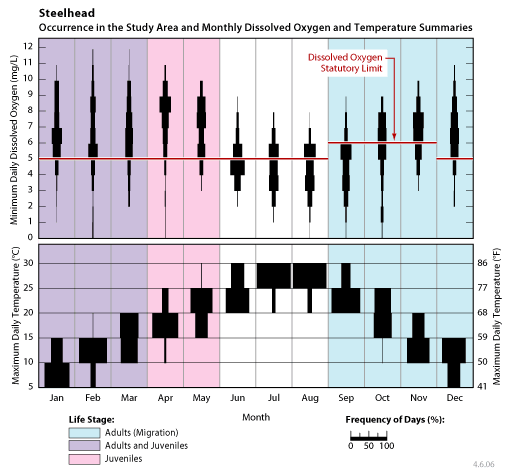
4. How well is this driver understood? The effects of high water temperatures and low DO concentrations on juvenile and adult steelhead and rainbow trout have been well documented in laboratory studies. The applicability of these studies to fish in their natural environment is limited because of environmental variability, the inability to document the specific environmental conditions to which fish are exposed, and the confounding effects of other environmental variables. Jump to "Steelhead" discussion under other Secondary Drivers: Chinook Salmon (Oncorhynchus tshawytscha) Hypothesis: High water temperatures encountered by migrating adult and juvenile Chinook salmon in the DWSC increase the incipient limiting and lethal threshold concentrations for DO (the level below which adverse effects may occur) above the thresholds under normal temperatures. 1. How does this driver operate? Many studies on the synergistic effects of water temperature and DO concentrations on Chinook salmon have been published. This species does not tolerate relatively high water temperatures and low DO concentrations. Additionally, higher water temperatures cause an increase in metabolic rate and corresponding increase in oxygen demand (Ebersole et al. 2001). The incidence of mortality from low DO concentrations is correlated with the length of exposure and water temperature. 2. Are there critical thresholds associated with this driver? In general, migrating and holding adults experience increased stress as water temperatures increase from 12 to 21°C, potentially resulting in deterioration in physical condition and reduced spawning success (McCullough 1999).
In general, juvenile Chinook salmon experience increased stress as water temperatures increase from 18 to 24°C, potentially resulting in impaired smolt transformation, reduced growth rates, and increased mortality.
3. How important is this driver? Water temperature is an important stress on adult and juvenile Chinook salmon and would be expected to exacerbate the effects of low DO concentrations in the DWSC. Adult Chinook salmon are expected to be migrating during the lowest DO concentrations and would be most affected by high water temperatures and poor water quality. Water temperatures are in the deleterious range in September and most days in October but improve in November (see figure below). For juvenile salmon, water temperatures from January through April are within the 5–20°C range but increase above 20°C in May, and by June all water temperatures are above 20°C. If smolts emigrate through the DWSC during the months of March through June when most of the water temperatures are above 15°C, smoltification could be prevented. 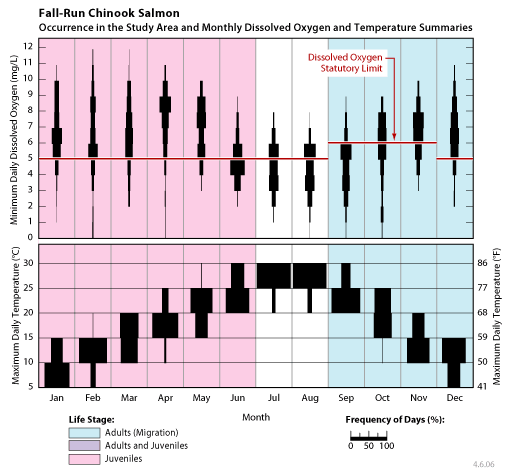
4. How well is this driver understood? The effects of water temperature on Chinook salmon and other salmonids are well understood and have been studied in both wild and captive fish. A good discussion of the synergistic effects of DO concentrations and temperature can be found in Moyle and Cech (2000). Jump to "Chinook Salmon" discussion under other Secondary Drivers: Delta Smelt (Hypomesus transpacificus) Hypothesis: High water temperatures found in the DWSC during periods when delta smelt are likely to be present raise the incipient limiting threshold for DO (the level below which the ability to function declines) compared to the threshold under normal temperature conditions. 1. How does this driver operate? High water temperature impairs the ability of delta smelt to use DO. The relationship among water temperature, fishes’ demands for DO, and their ability to extract oxygen from water is characterized by thresholds. Specifically, beyond a species-specific temperature, fish cannot extract oxygen from water, regardless of the concentration of oxygen in the water. Also, as temperature increases, fish require more oxygen to maintain basic metabolic functions. Finally, as temperature increases, the saturation concentration of oxygen in water decreases. 2. Are there critical thresholds associated with this driver? No studies of the relationship between temperature and DO available to delta smelt have been conducted; however, observation in the field and the laboratory (Swanson pers. comm.) suggests that delta smelt cannot access DO at water temperatures much above 20°C. Delta smelt are not able to tolerate high water temperatures that may occur in the DWSC. They are rarely found at temperatures above 20°C, and temperatures above 25.4°C are lethal (Swanson et al. 2000). Moyle (2002) speculated that larval delta smelt may experience temperature-related mortality at temperatures as low as 18°C. During September and October and during April and May, periods when delta smelt may occur there, temperatures in the DWSC regularly exceed 20°C (see figure below). The physiological stress associated with high water temperatures probably reduces delta smelt’s tolerance for low DO concentrations. 3. How important is this driver? The relationship between water temperature and tolerance for DO is a critical one because water temperatures in the DWSC regularly approach the physiological limit for delta smelt during the times when DO concentrations are also low (see figure below). 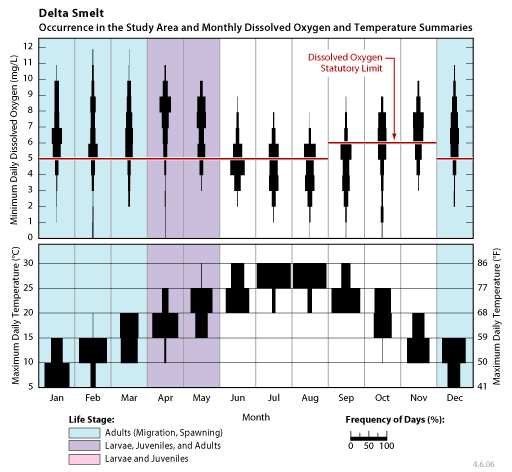
4. How well is this driver understood? No studies on the synergistic effects of water temperature and DO concentrations on delta smelt have been published. The sensitivity of delta smelt to high water temperatures is well documented (Swanson et al. 1996, 2000). Jump to "Delta Smelt" discussion under other Secondary Drivers: Longfin Smelt (Spirinchus thaleichthys) Hypothesis: High water temperatures found in the DWSC during periods when longfin smelt are likely to be present raise the incipient limiting threshold for DO (the level below which the ability to function declines) compared to the threshold under normal temperature conditions. 1. How does this driver operate? Longfin smelt are not likely to tolerate the high water temperatures that may occur at times in the DWSC. Water temperature is suspected to limit this species’ seasonal distribution in the Delta (Rosenfield and Baxter, pers. comm.). The physiological stress associated with high water temperatures would be expected to reduce the longfin smelt’s ability to tolerate low DO (General Effects). 2. Are there critical thresholds associated with this driver? The relationship between temperature and DO tolerance levels is defined by critical thresholds (General Effects). High water temperatures generally exacerbate the negative effects of low DO concentrations on fish. Critical thresholds for a DO/temperature interaction in longfin smelt have not been determined. 3. How important is this driver? The relationship between water temperature and tolerance of low DO is a critical one because water temperatures in the DWSC regularly approach the physiological limit for longfin smelt during the times when DO concentrations are also low (see figure below). 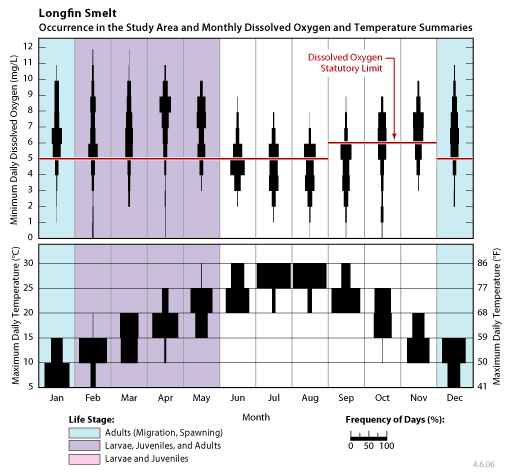
4. How well is this driver understood? No studies on lethal water temperatures for longfin smelt or the synergistic effects of water temperature and DO on longfin smelt have been published. Jump to "Longfin Smelt" discussion under other Secondary Drivers: Sacramento Splittail (Pogonichthys macrolepidotus) Hypothesis: High water temperatures found in the DWSC during periods when Sacramento splittail are likely to be present do not raise the incipient limiting threshold for DO (the level below which the ability to function declines) for Sacramento splittail compared to the threshold under normal temperature conditions. 1. How does this driver operate? No studies on the synergistic effects of water temperature and DO on Sacramento splittail have been published; however, temperature is probably not an important stress on Sacramento splittail and would not be expected to exacerbate the effects of low DO concentrations in the DWSC because this species is tolerant of relatively high water temperatures (Young and Cech 1996). Juvenile fish have a critical thermal maximum of more than 30°C; optimal growth conditions were calculated to be 24–25°C for fish acclimated to 20°C (Young and Cech 1996). Although thermal tolerance declines with age (Young and Cech 1996), the temperature tolerances of adult Sacramento splittail (under experimental conditions without oxygen limitation) appear to be within the range that adults would experience as they migrate to fresh water for spawning. 2. Are there critical thresholds associated with this driver? The relationship between temperature and low-DO tolerance levels is defined by critical thresholds (General Effects). High water temperatures generally raise the DO concentration at which fish experience adverse impacts. Critical thresholds for a DO-temperature interaction in Sacramento splittail have not been determined. 3. How important is this driver? High water temperatures probably have little effect on the ability of Sacramento splittail to tolerate low DO concentrations. These fish appear to be more tolerant of high water temperature conditions than many other native fishes in the Delta. 4. How well is this driver understood? Young and Cech (1996) documented the temperature and DO tolerances of Sacramento splittail of different ages (life stages) acclimated to different temperatures. Jump to "Sacramento Splittail" discussion under other Secondary Drivers: White Sturgeon (Acipenser transmontanus) Hypothesis: Temperature levels found in the DWSC during periods when white sturgeon are likely to be present raise the incipient limiting threshold for DO (the level below which the ability to function declines) compared to the threshold under normal temperature conditions. 1. How does this driver operate? The relationship among water temperature, fishes’ demands for DO, and their ability to extract oxygen from water is characterized by thresholds. Above a species-specific temperature, fish cannot extract oxygen from water regardless of the concentration of oxygen in the water. Also, as temperature increases, fish require more oxygen to maintain basic metabolic functions. Finally, as temperature increases, the saturation concentration of oxygen in water decreases. White sturgeon (and Acipenseridae in general) are sensitive to high water temperatures that may occur in the DWSC. White sturgeon spawning migrations may be dependent on the availability of cool water as these fish overwinter in fresh water between 7 and 12°C (Cech and Doroshov 2004). Egg production in white sturgeon requires that females be exposed to cold (ca. 10°C) water (Cech and Doroshov 2004). The hatching success of white sturgeon eggs decreases at water temperatures above 20°C, and no eggs hatch after incubation at and above 23°C (Wang et al. 1985 as in Cech and Doroshov 2004). Larval white sturgeon and green sturgeon (A. medirostris) both showed a marked decline in survivorship at temperatures above 20°C. Juvenile white sturgeon displayed significantly higher growth rates (62% faster under normoxic conditions, 333% faster under hypoxic conditions) at 20°C compared to 15°C, but growth at 25°C was not significantly faster than that observed at 20°C (Cech et al. 1984). 2. Are there critical thresholds associated with this driver? The relationship between temperature and DO tolerance levels is defined by critical thresholds (General Effects). High water temperatures generally exacerbate the negative effects of low DO concentrations on fish, and this is particularly true of members of genus Acipenser. Cech et al. (1984) demonstrated that increasing temperature increased the negative response of white sturgeon to low DO concentrations in terms of growth, activity, and mortality. The magnitude of the impact was greater as temperatures increased from 20 to 25°C compared with the increase from 15 to 20°C. Therefore, a temperature threshold with regard to DO requirements may exist between 15 and 25°C. 3. How important is this driver? The relationship between water temperature and tolerance for low DO concentrations is a critical one because water temperatures in the DWSC regularly approach the physiological limit for white sturgeon during the times when DO concentrations are also low (see figure below). 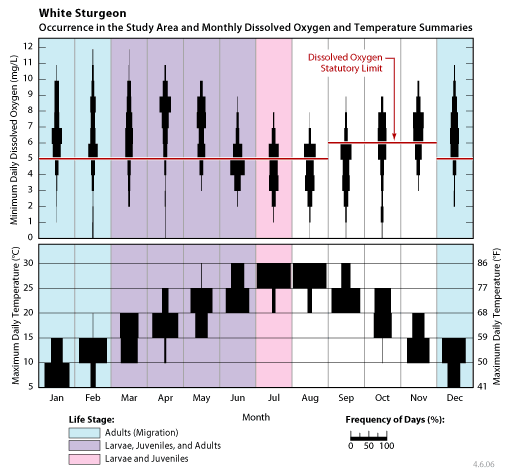
4. How well is this driver understood? The positive relationship between white sturgeon DO requirements and water temperature is well documented. Cech et al. (1984) demonstrated that increasing temperature increased the negative response of white sturgeon to low DO concentrations in terms of growth, activity, and mortality. This effect of temperature on DO requirements is also well known among other sturgeon. For example, Secor and Gunderson (1998) clearly demonstrated that Atlantic sturgeon tolerance (as measured by mortality) for low DO concentrations decreased as temperature increased. Jump to "White Sturgeon" discussion under other Secondary Drivers: Green Sturgeon (Acipenser medirostris) The relationship among water temperature, fishes’ demands for DO, and their ability to extract oxygen from water is characterized by thresholds. Above a species-specific temperature, fish cannot extract oxygen from water regardless of the concentration of oxygen in the water. Also, as temperature increases, fish require more oxygen to maintain basic metabolic functions. Finally, as temperature increases, the saturation concentration of oxygen in water decreases. Green sturgeon (and Acipenseridae in general) are sensitive to high water temperatures that may occur in the DWSC. As with other sturgeon species, larval green sturgeon (A. medirostris) showed a marked decline in survival at temperatures above 20°C (Cech and Doroshov 2004). Although little species-specific information is available for green sturgeon, it is likely that information for white sturgeon is generally applicable to green sturgeon. Jump to "Green Sturgeon" discussion under other Secondary Drivers: Striped Bass (Morone saxatilis) Hypothesis: High water temperatures found in the DWSC during periods when striped bass are likely present increase the incipient limiting threshold concentration for DO (the level below which the ability to function declines) compared to the threshold under normal temperatures. 1. How does this driver operate? See general discussion above. 2. Are there critical thresholds associated with this driver? A specific critical threshold for this mechanism is difficult to determine because of the simultaneous effect of temperature on oxygen solubility in water, blood oxygen affinity, and metabolic rate. Striped bass have a relatively broad physiological tolerance of higher water temperatures, with adult bass able to withstand large temperature changes associated with migration from salt water to fresh water. However, striped bass become stressed as temperatures approach 25°C, and temperatures above 30°C are usually fatal (Moyle 2002). Tolerance of temperatures as high as 34°C has been observed but only for short periods of time (Moyle 2002). Although striped bass may be able to tolerate increased temperatures, their thermal niche (the range of occupied temperatures around a physiologically optimum temperature) will be limited primarily by DO concentrations (Coutant 1990). Cech et al. (1984) showed that juvenile striped bass grew fastest at 25°C when DO concentrations were near saturation. In the same experiment, growth rates were reduced when DO concentrations neared hypoxia. Juvenile striped bass in lab environments have been shown to prefer 24–27°C (Coutant et al. 1984), and subadults and adults in freshwater reservoirs have been shown to prefer 20–24°C and 18–22°C, respectively (Coutant and Carrol 1980). 3. How important is this driver? The differential timing of adult and juvenile striped bass moving through the DWSC may dictate the potential for adverse effects associated with the high water temperature and low DO concentrations.
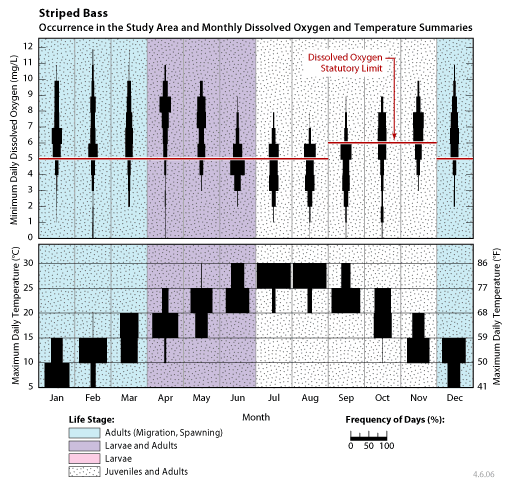
4. How well is this driver understood? The preferred range of temperatures for striped bass is well described in the available literature (see discussion above). Additionally, good discussions of the synergistic effects of DO and temperature can be found in Moyle and Cech (2000). Jump to "Striped Bass" discussion under other Secondary Drivers: |